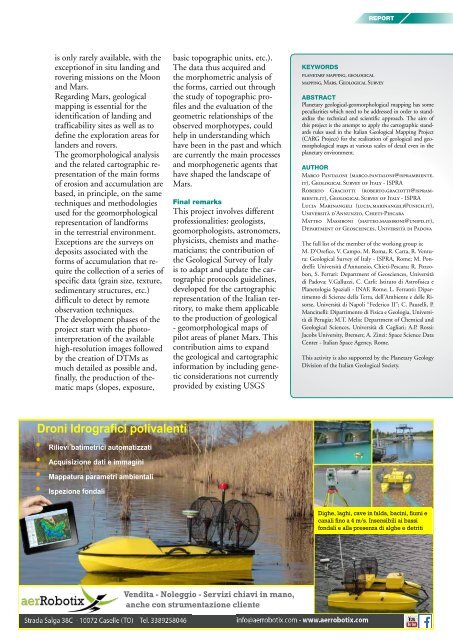You also want an ePaper? Increase the reach of your titles
YUMPU automatically turns print PDFs into web optimized ePapers that Google loves.
REPORT<br />
is only rarely available, with the<br />
exceptionof in situ landing and<br />
rovering missions on the Moon<br />
and Mars.<br />
Regarding Mars, geological<br />
mapping is essential for the<br />
identification of landing and<br />
trafficability sites as well as to<br />
define the exploration areas for<br />
landers and rovers.<br />
The geomorphological analysis<br />
and the related cartographic representation<br />
of the main forms<br />
of erosion and accumulation are<br />
based, in principle, on the same<br />
techniques and methodologies<br />
used for the geomorphological<br />
representation of landforms<br />
in the terrestrial environment.<br />
Exceptions are the surveys on<br />
deposits associated with the<br />
forms of accumulation that require<br />
the collection of a series of<br />
specific data (grain size, texture,<br />
sedimentary structures, etc.)<br />
difficult to detect by remote<br />
observation techniques.<br />
The development phases of the<br />
project start with the photointerpretation<br />
of the available<br />
high-resolution images followed<br />
by the creation of DTMs as<br />
much detailed as possible and,<br />
finally, the production of thematic<br />
maps (slopes, exposure,<br />
basic topographic units, etc.).<br />
The data thus acquired and<br />
the morphometric analysis of<br />
the forms, carried out through<br />
the study of topographic profiles<br />
and the evaluation of the<br />
geometric relationships of the<br />
observed morphotypes, could<br />
help in understanding which<br />
have been in the past and which<br />
are currently the main processes<br />
and morphogenetic agents that<br />
have shaped the landscape of<br />
Mars.<br />
Final remarks<br />
This project involves different<br />
professionalities: geologists,<br />
geomorphologists, astronomers,<br />
physicists, chemists and mathematicians;<br />
the contribution of<br />
the Geological Survey of Italy<br />
is to adapt and update the cartographic<br />
protocols guidelines,<br />
developed for the cartographic<br />
representation of the Italian territory,<br />
to make them applicable<br />
to the production of geological<br />
- geomorphological maps of<br />
pilot areas of planet Mars. This<br />
contribution aims to expand<br />
the geological and cartographic<br />
information by including genetic<br />
considerations not currently<br />
provided by existing USGS<br />
KEYWORDS<br />
planetary mapping, geological<br />
mapping, Mars, Geological Survey<br />
ABSTRACT<br />
Planetary geological-geomorphological mapping has some<br />
peculiarities which need to be addressed in order to standardize<br />
the technical and scientific approach. The aim of<br />
this project is the attempt to apply the cartographic standards<br />
rules used in the Italian Geological Mapping Project<br />
(CARG Project) for the realization of geological and geomorphological<br />
maps at various scales of detail even in the<br />
planetary environment.<br />
AUTHOR<br />
Marco Pantaloni (marco.pantaloni@isprambiente.<br />
it), Geological Survey of Italy - ISPRA<br />
Roberto Graciotti (roberto.graciotti@isprambiente.it),<br />
Geological Survey of Italy - ISPRA<br />
Lucia Marinangeli (lucia.marinangeli@unich.it),<br />
Università d’Annunzio, Chieti-Pescara<br />
Matteo Massironi (matteo.massironi@unipd.it),<br />
Department of Geosciences, Università di Padova<br />
The full list of the member of the working group is:<br />
M. D’Orefice, V. Campo, M. Roma, R. Carta, R. Ventura:<br />
Geological Survey of Italy - ISPRA, Rome; M. Pondrelli:<br />
Università d’Annunzio, Chieti-Pescara; R. Pozzobon,<br />
S. Ferrari: Department of Geosciences, Università<br />
di Padova; V.Galluzzi, C. Carli: Istituto di Astrofisica e<br />
Planetologia Spaziali - INAF, Rome; L. Ferranti: Dipartimento<br />
di Scienze della Terra, dell’Ambiente e delle Risorse,<br />
Università di Napoli “Federico II”; C. Pauselli, P.<br />
Mancinelli: Dipartimento di Fisica e Geologia, Università<br />
di Perugia; M.T. Melis: Department of Chemical and<br />
Geological Sciences, Università di Cagliari; A.P. Rossi:<br />
Jacobs University, Bremen; A. Zinzi: Space Science Data<br />
Center - Italian Space Agency, Rome.<br />
This activity is also supported by the Planetary Geology<br />
Division of the Italian Geological Society.<br />
Droni Idrografici polivalenti<br />
• Rilievi batimetrici automatizzati<br />
• Acquisizione dati e immagini<br />
• Mappatura parametri ambientali<br />
• Ispezione fondali<br />
Dighe, laghi, cave in falda, bacini, fiumi e<br />
canali fino a 15 4 m/s. Km/h. Insensibili ai bassi ai bassi<br />
fondali e alla presenza di alghe e detriti<br />
Vendita - Noleggio - Servizi chiavi in mano,<br />
anche con strumentazione cliente<br />
<strong>GEOmedia</strong> n°3-<strong>2019</strong> 15


















